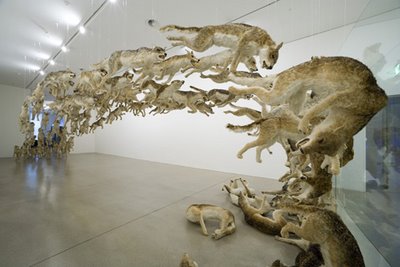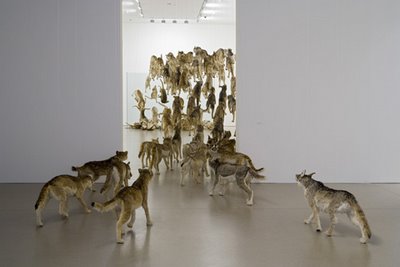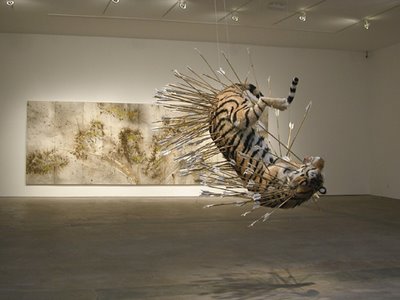Monday, February 26, 2007
Friday, February 23, 2007
shortcuts for Microsoft Outlook
Here are a list of shortcuts to help you move faster in Microsoft Outlook:
Alt + . (period) Open the Address Book with the To field selected
Alt + A Open the Action drop-down menu
Alt + B Open the Address Book with the BCC field selected
Alt + C Select message recipients for CC field
Alt + D Switch to Daily calendar view
Alt + E Open the Edit drop-down menu
Alt + F Open the File drop-down menuAlt + G Open the Go drop-down menu
Alt + H Open the Help drop-down menu
Alt + I Open the Find tool bar / Open the Insert drop-down menu
Alt + J Move to the Subject field
Alt + K Check names in the To, CC, or BCC field against the Address Book (cursor must be in the corresponding message header field)
Alt + L Reply All
Alt + M Switch to Monthly calendar view
Alt + N Open the Accounts drop-down menu
Alt + O Open the Format drop-down menu / Switch to Today calendar view
Alt + P Open the Message Options dialog box
Alt + R Reply / Switch to Work Week Calendar view
Alt + S Send
Alt + T Open the Tools drop-down menu
Alt + V Open the View drop-down menuAlt + W Forward an item / Switch to Weekly calendar view
Alt + Y Switch to Daily calendar view
Ctrl + 1 Go to Mail
Ctrl + 2 Go to Calendar
Ctrl + 3 Go to Contacts
Ctrl + 4 Go to Tasks
Ctrl + 5 Go to Notes
Ctrl + 6 Go to Folder List
Ctrl + 7 Go to Shortcuts
Ctrl + 8 Go to Journal
Ctrl + A Select all
Ctrl + B Bold when editing a rich text message
Ctrl + C Copy
Ctrl + D Delete an item (message, task, contact, etc.)
Ctrl + E Activate the Find drop-down menu / Center Align when editing a rich text message
Ctrl + F Forward
Ctrl + J Open a new Journal Entry from the selected item (message, task, contact, etc.)
Ctrl + K Check names in the To, CC, or BCC field against the Address Book (cursor must be in the corresponding message header field)
Ctrl + M Send/Receive all
Ctrl + O Open
Ctrl + P Print
Ctrl + Q Mark the selected message Read
Ctrl + R Reply
Ctrl + S Save a draft message
Ctrl + T Tab
Ctrl + U Mark the selected message Unread
Ctrl + V Paste
Ctrl + X Cut
Ctrl + Y Go to Folder
Ctrl + Z Undo
Ctrl + Backspace Delete the previous word
Ctrl + End Move to the end
Ctrl + Home Move to the beginning
Ctrl + Shift + A Open a new Appointment
Ctrl + Shift + B Open the Address Book
Ctrl + Shift + C Create a new Contact
Ctrl + Shift + E Open a new folder
Ctrl + Shift + F Open the Advanced Find window
Ctrl + Shift + G Flag message for follow up
Ctrl + Shift + J Open a new Journal Entry
Ctrl + Shift + K Open a new Task
Ctrl + Shift + L Open a new Distribution List
Ctrl + Shift + M Open a new Message
Ctrl + Shift + N Open a new Note
Ctrl + Shift + O Switch to the Outbox
Ctrl + Shift + P Open the New Search Folder window
Ctrl + Shift + Q Open a new Meeting Request
Ctrl + Shift + R Reply All
Ctrl + Shift + S Open a new Discussion
Ctrl + Shift + U Open a new Task Request
Ctrl + Shift + Y Copy a Folder
Shift + Tab Select the previous message header button or field
F1 Open Outlook Help
F3 Activate the Find toolbar
F4 Open the Find window
F7 Spellcheck
F9 Send and receive all
F10 Select File from the Outlook toolbar button
F11 Activate the "Find a contact" dialog box
F12 Save As
Alt + F4 Close the active window
From - Bhoomi Patel
join me at : Join SMS Group
http://groups.yahoo.com/group/freesmsindia/join
Also Enjoy our website :
www.kathiyavad.com
www.groupstalk.com
History of Valentine's Day






Ever Wonder Who St. Valentine Was? Or why so many people get all mushy around the second week of February? Here's a brief synopsis:
St. Valentine was actually two people (that weren't romantically involved) who were martyred on the same day (c. 270). Feasts commemorating them were celebrated on February 14. One was a priest and physician who died in Rome during the persecution of Christians by Claudius II Grothicus. The other was the bishop at Terni, Italy who was also martyred in Rome. Both have been buried at different places along the Flaminian Way.
So why do people send "valentines" or "love-tokens" to one another on that day? The origin of that tradition is not thought to have any connection with the saint's day. Rather it comes from an early European belief that the second week of February was when birds began to mate. The idea suggests that lovers should probably exchange notes and gifts on February 14 in conjunction with what nature practiced.
During this time Claudius II was the emperor of Rome. He liked war, but had a hard time building an army. Claudius thought it was because men didn't want to leave their wives and families. So, he banned all marriages. But Saint Valentine, a Roman Catholic priest, continued to perform marriages in secret. His good deeds came to an end when he was caught and sentenced to die. While in jail, he fell in love with the jailer's daughter. And on February 14, 270 A.D., the day of his death, he sent her a note signed, "From, your Valentine." (In 469 A.D., February 14th was set aside to honor St. Valentine.)
Valentine's Day isn't just about flowers, chocolates and sappy cards. It isn't about red hearts and white teddy bears. And it's definitely not about Cupid. Valentine's Day is about love. A love that cannot be commercialized. That cannot be bought. A love that seems elusive, yet most of us continue to search for it. We want to experience love because it is a powerful, pure emotion. And we're told in the Bible that "Love never fails" (1 Corinthians 13:8).
The cross of Calvary is proof that the love of God will never fail. The splintered wood. The nails. The crown of thorns. The painful death of Jesus. Evidence of the greatest sacrifice, so we would know the meaning of love.
This Valentine's Day, show love. Give a card to your enemy. Be nice to the guy who cuts in the lunch line. Smile at the girl who never smiles. And most importantly, love the way Christ loves us.








From - Bhoomi Patel
join me at : Join SMS Group
http://groups.yahoo.com/group/freesmsindia/join
Also Enjoy our website :
www.kathiyavad.com
www.groupstalk.com
(painting on hand)
From - Bhoomi Patel
join me at : Join SMS Group
http://groups.yahoo.com/group/freesmsindia/join
Also Enjoy our website :
www.kathiyavad.com
www.groupstalk.com
Thursday, February 22, 2007
Something Special










From - Bhoomi Patel
join me at : Join SMS Group
http://groups.yahoo.com/group/freesmsindia/join
Also Enjoy our website :
www.kathiyavad.com
www.groupstalk.com
BeauTy oF InnOcenCe
BeauTy oF InnOcenCe
From - Bhoomi Patel
join me at : Join SMS Group
http://groups.yahoo.com/group/freesmsindia/join
Also Enjoy our website :
www.kathiyavad.com
www.groupstalk.com












































